The work that Joseph Smith, the first Prophet of The Church of Jesus Christ of Latter-day Saints, performed in translating the Bible helps to enhance our understanding of some of the previously misunderstood and misinterpreted passages of scripture. This insightful work is known as the Joseph Smith Translation (JST) or the New Translation (NT). The question we must ask ourselves today is “Why did Joseph Smith feel compelled to do a revision of some Biblical texts?” and, “Why are those revisions important?”
Revisions Made by Inspiration from the Lord
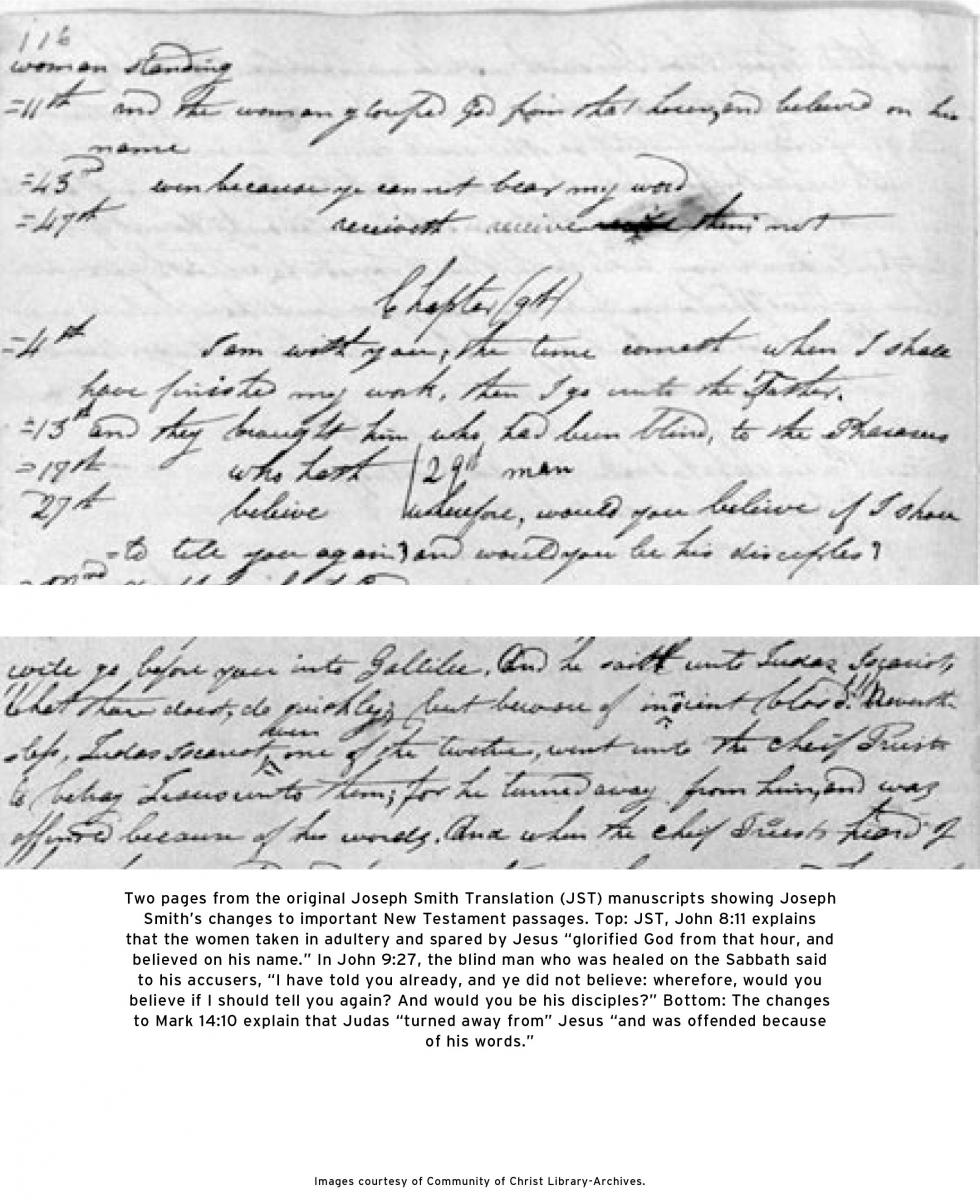 The short answer to the aforementioned questions is that the Lord instructed Joseph Smith to make some revisions (see Doctrine and Covenants 124:89 and also History of the Church vol. 1 pg. 341, 365 and vol. 4, pg.164).
The short answer to the aforementioned questions is that the Lord instructed Joseph Smith to make some revisions (see Doctrine and Covenants 124:89 and also History of the Church vol. 1 pg. 341, 365 and vol. 4, pg.164).
The Book of Mormon was at the printer being typeset. It was not published until 26 March 1830. Joseph Smith organized the Church on 6 April 1830, and after the Church was organized, he was instructed by the Lord to undertake a careful reading of the Bible and make revisions according to inspiration he would receive from the Lord. By this time he was already a seasoned translator.
Joseph once stated that “many important points touching the salvation of man, had been taken from the Bible, or lost before it was compiled. (Taken from the papers of JS vol.1 pg 372 edited by Dean C. Jessee (Salt Lake City, Deseret Book, 1989). His comments also seemed to parallel those made by Book of Mormon Prophet Nephi that “many plain and precious things “would be “taken away” from it (the Bible). (See 1 Nephi 13:28; 13:23-29.)
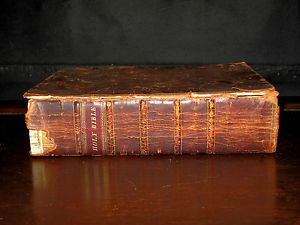 Joseph had purchased a Bible from the E.B. Grandin Bookstore in Palmyra, New York on 8 October 1829. The Bible used by Smith was published by the H. & E. Phinney Company of Cooperstown, New York. The text of the Bible purchased by Joseph closely resembled the 1769 version of the King James Bible. However, that Bible had been modernized. Hundreds of verses, including some wording and punctuation, were different. The Bible that he purchased was typical of his day, and can be found today in the Archives of the Community of Christ in Independence, Missouri.
Joseph had purchased a Bible from the E.B. Grandin Bookstore in Palmyra, New York on 8 October 1829. The Bible used by Smith was published by the H. & E. Phinney Company of Cooperstown, New York. The text of the Bible purchased by Joseph closely resembled the 1769 version of the King James Bible. However, that Bible had been modernized. Hundreds of verses, including some wording and punctuation, were different. The Bible that he purchased was typical of his day, and can be found today in the Archives of the Community of Christ in Independence, Missouri.
Notes on Biblical Revisions
Historically, revisions of the biblical text have been made to the English Bibles in an effort to improve readability since much of the language was arcane and unintelligible to modern readers. Moreover, it is useful to understand the context and cultural implications of biblical times. Hence, biblical texts were prone to misunderstanding and misinterpretation even by the standards of the day. Many Bible verses were modified, then as they are today, and rewritten by various religions and publishers to improve theological clarity, agreement, and understanding. The Bible that Joseph used was no exception.
Joseph’s re-translation consisted of roughly thirteen hundred Old Testament verses and roughly twenty one hundred verses in the New Testament. Most of the changes were merely re- wordings of the text from the King James Version (KJV) translation which served as the underlying text for his revisions.
What did Joseph Smith add to the Biblical text?
Joseph added some new material. In some cases he added liberal amounts of new material. It is generally believed that he examined every book in the Bible. Notwithstanding, no changes were made in thirteen of the books (Ester, Ecclesiastes, Songs of Solomon, Lamentations, Obadiah, Micah, Nahum, Habakkuk, Zephaniah, Haggai, Malachi, and 2nd & 3rd John). He also wrote in the margin of his Bible that the Song of Solomon was not inspired writing.
Criticism of the JST in Journal of Mormon Thought
In the fall of 1986, author Kevin L. Barney wrote an article for the Journal of Mormon Thought. The article was titled “The Joseph Smith Translation (of the Bible) and Ancient Texts of the Bible.” In the article he dismissed the Joseph Smith Translation (JST -This was the name given the original manuscript in 1970, previously known as the “Inspired Version” Bible). According to his perspective, the changes were not verifiable with ancient manuscripts. He claimed that the JST revisions were justifiable only if they were to agree with the earliest existing manuscripts of biblical books.
Barney’s theory presupposes that the purpose of the JST translation of the Bible was to restore original text that had been changed or altered over the centuries. This claim was never made in the JST translation or by Joseph Smith during his lifetime. His theory also ignores the historical record that the earliest known manuscripts of the New Testament were written in the first century, or perhaps several centuries later, and the oldest versions of the Old Testament have never been made available to modern translators or biblical scholars. It is also important to note the term “scientifically verifiable” as posited by Barney is lacking in a faith context.
Inspiration and the exercise of faith are essential in the interpretation of the Bible. These things can only by clarified through prayer and the presence and witness of the Holy Spirit. Scholars and theologians cannot be certain that even the earliest biblical manuscripts which are available today, including the most ancient, are identical to the Bible manuscripts, or if they came from the pen of the originally credited writers. Additionally, we do not have some of the original manuscripts. They are only referenced in later times. They are, quite simply, lost to history. Another matter of consideration is that the biblical prophets often quoted each other in unanticipated ways. Thus, the Bible which Joseph purchased in 1829 became the underlying text for the JST translation of the Bible as opposed to ancient verifiable texts of the Bible suggested by Barney. In addition, the JST is written in the modern vernacular of Joseph Smith.
From the perspective of Joseph Smith and the Church in general, the JST (although only portions of the JST are canonized), Book of Mormon, and KJV Bible are not, nor were they ever intended to be, museum pieces. Rather, they are held as inspired scripture to guide and enlighten modern day church members (sometimes referred to as “Saints”). The specific portions of the JST that are canonized by The Church of Jesus Christ are the Pearl of Great Price which includes the Book of Moses, a significant manuscript that is not found in the Old Testament, the first two books of Genesis, and Mathew 24.
Mormons accept the English version of the authorized KJV as canon (authorized by an act of the English Parliament under the reign of King James). However, in Church-published Bibles there are supplemental materials – footnotes, topical dictionaries, maps and lesson manuals (Mormon Extras) – and the JST references are included. Notwithstanding, these references and materials do not carry the weight of canonization with the exception of those cited in the previous paragraph. At times in Mormon literature the JST may be quoted authoritatively, however, it is technically not considered a part of the canon of scripture. It appears that with, or without the supplemental material, the authorized KJV is acceptable, but the preference would be the authorized KJV with the “Mormon extras” for greater clarity and understanding.
The Work Continued Amidst Opposition
The primary work of Joseph’s revision of the Bible was done from 1830 -1833 (approximately three years), with most of the significant contributions of the JST being made during that time. The prophet dedicated himself as much as possible to his Bible correction and translation projects while simultaneously leading the infant church. After 1833, people listening to Joseph’s discourses on biblical subjects and principles were often astounded at the depth and breadth of his familiarity with the KJV Bible.
Joseph’s work on the Bible manuscript was often temporarily interrupted because of temporal needs— i.e. providing for his family, leadership quandaries with the new Church, numerous problems including problematic neighbors and local people who misunderstood or disliked church members, legal issues, and issues with lack of redress by state and Washington politicians when both he and members of the Church were deprived of life, liberty and property due to frontier justice and mob violence, all of which was blatantly illegal. These injustices and abuses were perpetrated by individuals (often apostates) who stirred up discontent and unhappiness resulting in mob violence by state and federal government abuses and edicts. For example, in Missouri, Governor Boggs issued issued an “extermination order” on 27 October 1838, allowing anyone to shoot and kill Mormons on sight. A Federal example was the Utah War in 1856-57.
How Revisions of the Bible Were Made
The revisions made by Joseph consisted of two types:
1) Mechanical, i.e. insertions of punctuation, verse numbering, changes of ampersands and corrections of capitalization or modification of lower and upper case letters.
2) Some of the revisions involved the changing of words or a revision of word order.
Some of the insertions in the JST lacked room in the columns or margins to complete the revisions. To overcome this mechanical problem, revisions were written on small pieces of paper and were attached in place with straight pins.
During the revision (translation), Joseph worked under the direction of the Lord and made improvements that were both doctrinal and grammatical. However, the record shows he also struggled with the wording. Even under the direction of the Holy Spirit, the translation was not just “handed to him.” He was told by the Lord in revelation that he should “study it out in his mind” (also applicable to us) and that as he (we) listened to the Spirit, he (we also) should apply his (our) best efforts, after which a confirmation would come if it is correct (See Doctrine and Covenants 9:8; Doctrine and Covenants 9:7-9).
Moreover, Mormons acknowledge that during the translation process the prophet’s eyes may have skipped words during the dictation, or that his scribe may have recorded some words incorrectly. Critical analysis of the JST shows that Sidney Rigdon was the scribe for roughly 90% of the JST Bible revision, and Frederick G. Williams served as scribe for most of the remaining portion. Only ten small changes were actually penned by the prophet himself. Ironically, the JST, although criticized by many, was similar to previous revisions made by others of the Bible through the centuries and in modern times. However, Joseph’s revision was far from ordinary. It was done under commandment from the Lord and with guidance from the Holy Spirit.
Williams was excommunicated in 1838, but returned in 1842, and died shortly thereafter. Sidney Rigdon was also excommunicated shortly after Joseph’s death in the Carthage jail in Carthage, Illinois. These excommunications constituted a severe setback for church acceptance and understanding of the JST.
The Mormon view of the Bible
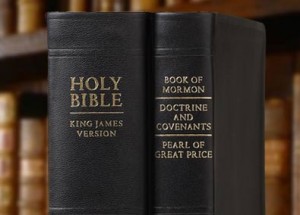 Mormons believe that the books of the Bible were written under the inspiration of the Lord, subject to the interpretation of imperfect authors. However, they also understand that just because authors are fallible, it does not mean that they were not moved by the Spirit of God or that they were uninspired.
Mormons believe that the books of the Bible were written under the inspiration of the Lord, subject to the interpretation of imperfect authors. However, they also understand that just because authors are fallible, it does not mean that they were not moved by the Spirit of God or that they were uninspired.
It should come as no surprise that the authors of the Bible were imperfect people. Scriptures never idealize early Christians, even when they were the “first generation.” Rather, the scriptural record is replete with stories of the imperfections of early followers of Christ— including prophets like Moses, who was not allowed into the “promised land” because of his personal faults (see Numbers 20:12). Even the leader of the Apostles in the New Testament, Peter, prophetically denied even knowing his Master in the hour of His greatest need. (See Matt. 26:69-75, Luke 22:55-62, John 18:17-18, 26-27.) Ironically, these stories of imperfect people and prophets also serve as a lesson of hope for us today.
In the Book of Mormon, the Prophet Nephi tells us of human foibles in keeping records of faith (1 Nephi 19:6). The Book of Mormon is similar in style to the Bible. In one of the books of the Book of Mormon (1 Nephi 13:28; 13:23-29), the Mormon dilemma with the Bible is clearly outlined. However, the Bible and the Book of Mormon together serve as a double witness to the divinity of Christ’s mission.
The Aftermath of Joseph Smith’s Martyrdom as Related to the JST
Joseph Smith was murdered on 27 June 1844 by a mob in Illinois which delayed the publication of the JST Bible indefinitely.
Understandably, Emma, Joseph’s wife, was exhausted both emotionally and physically by the years of conflict and trouble that eventually led to her husband’s death and the problems encountered after his death. Emma was pregnant at the time and had already suffered a stroke. Joseph’s immediate family decided to remain in Nauvoo, Illinois, where the prophet and his family lived. Emma also felt the need to remain to tend her husband’s grave.
There were also legal difficulties separating Joseph’s personal property from those Joseph held as Trustee-in Trust for the Church. After his murder, church trustees seized the contents of his personal office. Emma vehemently objected to the seizure of the contents of Joseph’s office. Joseph’s Bible and revised manuscript were not in his office. The manuscript was at his home in Emma’s custody. Thus, Joseph’s family was able to retain the working manuscript of the JST.
Brigham Young was serving in the Church as the President of the Quorum of the Twelve Apostles, a governing body of the Church. Young attempted to obtain the original copy of the JST, even begging, but Emma adamantly refused all of his attempts. Young then sought out the most qualified person to persuade Emma, Willard Richards, who was Joseph’s personal secretary, church historian and a true friend and confidant to Emma and Joseph. Richards was present with the Prophet when Joseph and his brother Hyrum were attacked and killed by a mob in the Carthage jail. He survived the attack, and afterwards, was placed in charge of the recovery and removal of Hyrum and Joseph’s bodies. Even with his status and friendship with the Smith’s, he was not successful in persuading Emma to give Young the manuscript.
During his lifetime, Smith attempted to collect funds to publish his Bible revision and he never lost interest in his project, but at the time of his death, although he had hoped to publish it, it had not been published.
The Prophet’s Brother is Excommunicated, further alienating the Smith family and delaying the JST publication
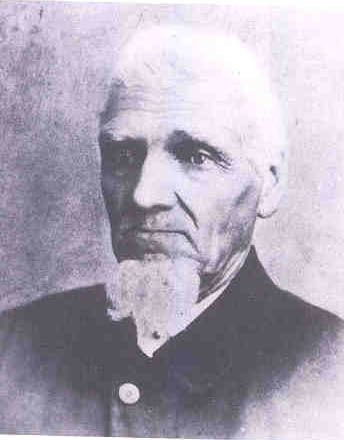 Many church members believed that Joseph III should succeed his father. He had been blessed by his father that if he lived righteously he had the possibility of becoming the next prophet. At the time of his father’s death young Joseph III was only 11 years old. This made it impractical for him to become the next leader of the Church.
Many church members believed that Joseph III should succeed his father. He had been blessed by his father that if he lived righteously he had the possibility of becoming the next prophet. At the time of his father’s death young Joseph III was only 11 years old. This made it impractical for him to become the next leader of the Church.
With this line of reasoning, the next possible candidate would have been the prophet’s brother Samuel. However, Samuel got sick and died about one month after Joseph and his uncle Hyrum’s martyrdom, probably as the result of trying to handle events concurrent to Joseph’s martyrdom, riding on horseback hundreds of miles in inclement weather –leaving the Smith family– including his sisters and an only surviving brother, William. It should be noted that William was the only member of the Smith family rebellious against the gospel and never consistently supportive of the prophet. Nevertheless, he was eventually ordained to succeed his uncle Hyrum Smith as the Presiding Patriarch of the Church on 24 May 1845. Brigham Young took exception to William’s claim that he was patriarch over the Church and printed a clarification in a church newspaper stating that William had not been ordained as patriarch over the Church, but rather as patriarch to the Church. Although William took the clarification as a personal affront, he continued as apostle and patriarch to the Church until 6 October 1845, when according to church practice, William’s name was read for a sustaining vote of support at General Conference. Unexpectedly, fellow apostle Parley P. Pratt expressed an objection to sustaining William based on his “character and miscreant practices.” The conference attendees re-voted— unanimously deciding not to support William as an apostle- or as church patriarch.
William was subsequently disfellowshipped from the Church. Shortly thereafter, he wrote a lengthy personal attack on Brigham Young and other members of the Quorum of the Twelve. He compared Young to Pontius Pilate and Nero and accused Young and the others of secretly keeping multiple “spiritual wives.” The attack was published in a local newspaper Sharp’s Warsaw Signal. As a result of William’s statement in the newspaper, he was deemed an apostate and excommunicated from the Church by Young and the remaining members of the Quorum of the Twelve Apostles on 19 October 1845. This incident further alienated the Smith Family and made certain that the JST would likely be a long time in coming to the general church membership.
Whatever happened to Emma, the deceased prophet’s wife?
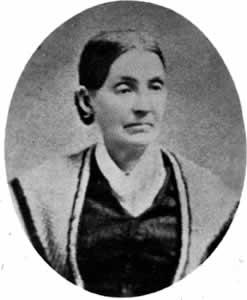 Emma remarried in December 1847. Her new husband was Major Lewis Crum Bidamon, and the wedding took place in a Methodist parsonage with the ceremony officiated by a Methodist circuit rider. Emma was sharply criticized by Western migrating Saints for not emigrating West and for remarrying a man who was not LDS and did not believe Joseph Smith was a prophet. Bidamon believed Joseph was an honest man but that he had been deceived. In later years, whenever anyone from the West returned for a visit, there were always reports about the Bidamon’s and their activities.
Emma remarried in December 1847. Her new husband was Major Lewis Crum Bidamon, and the wedding took place in a Methodist parsonage with the ceremony officiated by a Methodist circuit rider. Emma was sharply criticized by Western migrating Saints for not emigrating West and for remarrying a man who was not LDS and did not believe Joseph Smith was a prophet. Bidamon believed Joseph was an honest man but that he had been deceived. In later years, whenever anyone from the West returned for a visit, there were always reports about the Bidamon’s and their activities.
Emma and her new husband ran a hotel called the Mansion House Hotel that Emma and Joseph had planned and built. They also managed a small farm. Her children were tolerant of their new stepfather and bonded to him during their childhood years. (See Nauvoo Panorama, Cannon, Janath 1991, Nauvoo Restoration Inc., pages 52-53).
Emma, and a remaining contingent who decided not to go West– eventually reorganized in 1860. The reorganized church was called the Reorganized LDS Church (RLDS) and Emma convinced Joseph Smith III to become their first Church President. Joseph Smith III was initially reluctant because of all that had happened to his father. The RLDS consider the years from 1844 (the year of Joseph Smith’s martyrdom) to 1860 to be a period of disorganization of the LDS church. The Reorganized LDS (RLDS) renamed their church the Community of Christ in 2001.
It should be noted that when the JST manuscript was submitted to the publication committee of the RLDS in 1866-67, Emma instructed the brethren to make a copy, thus they only had limited access. The JST was published by the RLDS in 1867 under the title of Holy Scriptures-Translated and corrected by the Spirit of Revelation by Joseph Smith Jr. Prophet and Seer.
Canonized Portions of the JST
In 1851 Elder Franklin D. Richards, (Nephew of Willard Richards) was one of the twelve apostles of the Utah-based Church and was serving as a mission president in Liverpool England. Richards felt that some of Smith’s revelations that had already been published in America in the Times and Seasons (a Church-run newspaper) and other church publications in the 1840’s would be a valuable addition to the missionary effort.
He created a pamphlet he called the Pearl of Great Price (PGP). It included the Book of Moses—the most significant portion of the JST manuscript (not found in the Old Testament), the first two books of Genesis, and Matthew 24. Notwithstanding, Richards’ pamphlet was well received and became a popular item among church members. In the 1870’s it was prepared for church-wide distribution. The first reprinting occurred in 1878 in Salt Lake City. Later in the Church General Conference of 1880, church leadership presented it to assembled congregants for a sustaining vote and canonization as scripture and it became a binding document on the Church. Thus, portions of the JST were canonized.
However, apart from the Pearl of Great Price, little was known among the Utah church members about the JST. Some church members assumed it was not meant to be published during Smith’s lifetime and held that since the Utah Church had accepted the authorized KJV Bible, it was unnecessary. Additionally, there was ample misunderstanding about the process by which the JST was created, questions about the accuracy of the passages, and questions as to why it was not published by Joseph himself. It appeared that few church members in the West remembered how Joseph had sought donations and assistance to publish his revised Bible.
Another Episode Casting Suspicion on the JST among the Utah Latter-day Saints
The perception of rejection of the JST was further fueled by an episode in 1867, where Joseph Smith III, the eldest surviving son of the late prophet, sent a copy of a published RLDS version titled the Holy Scriptures-Translated and corrected by the Spirit of Revelation by Joseph Smith Jr. Prophet and Seer to his childhood friend Orson Hyde in Salt Lake City. Hyde promptly embraced the Book and gave a sermon on the contents to his congregation (ward). He was later summoned to Brigham Young’s Home and his copy was confiscated and he was required to make a retraction.
We do not know exactly why Brigham Young rejected the RLDS publication sent to Orson Hyde. He had a partial copy of the JST translation manuscripts created by John Milton Bernhisel. We know that he manuscripts and source material could not be physically compared. Additionally he likely had personal knowledge that Joseph had been instructed by the Lord to study it out in his mind to render the best translation. (See Doctrine and Covenants 9:8; Doctrine and Covenants 9:7-9). Young also likely knew that Joseph continued to make minor improvements as he struggled to get the wording ” just right” up until the time of his death in 1844. However, Young did not consider the RLDS work acceptable as a separate work of canonized LDS scripture.
Recent Acceptance of the JST by Utah Based LDS Church
The animosity between the Utah LDS Church and the RLDS continued in part because the RLDS refused to allow the Utah based LDS to view the original manuscripts of the JST. This misunderstanding and contention between the LDS and the RLDS (Community of Christ) continued until 1968 when BYU Professor Robert J. Mathews decided to befriend the RLDS with the Church’s blessing. Over a 15 year period of friendship Mathews eventually gained access to the original manuscripts. It was the first time since 1845 anyone in the Utah based Church had actually seen, yet alone been given free rein, to critically examine these important documents. Mathews and his team of BYU archivists assisted the RLDS in stabilizing and preserving the original documents. In 1995 The Church of Jesus Christ assisted the RLDS in making the first electronic scan of the original JST manuscript.
The manuscripts, plus scholarly and historical material now available, are an invaluable resource for both churches. Both churches have also participated in numerous community service and education projects since Mathew’s initial efforts. Mathews died in October 2013. He was 82. He is credited among the LDS Church hierarchy for bringing to their attention the importance of the JST.
In 1979 The Church of Jesus Christ published a new Latter-day Saint Edition of the Bible in English. The volume contained ample amounts of new material from the JST, but only in the form of footnotes and references. No actual changes were made to the text of the KJV. Today the JST is openly discussed among the Latter-day Saints, even taught authoritatively, although only portions are actually canonized as scripture in the Church. The Church of Jesus Christ of Latter-day Saints is currently working on making the JST references and “Mormon extras” available in multiple languages.
—————————————–
Additional Reading:
An excellent historical summary of RLDS and LDS attitudes toward the JST is found in Thomas L. Sherry’s 1988 BYU dissertation entitled Attitudes, Practices, and Positions Toward Joseph Smith’s Translation of the Bible: A Historical Analysis of Publications, 1847-1987. Sherry documents the differing positions and summarizes his findings with the following comparisons. His parallel column arrangement (found on page 10) provides both a summary and overview of the shift in attitudes found within the RLDS and LDS Churches regarding the Joseph Smith Translation (Sherry 1988, 165-167).
| RLDS POSITION TO 1900 | RLDS POSITION, 1987 |
| a. The work of revision was divinely commanded, guided, and completed. | a. Joseph Smith perceived his work of Bible revision as being divinely commanded, guided, and sufficiently complete to warrant publication plans. |
| b. The revision clarified and corrected many difficult and erroneous aspects present in other versions, and “restored many plain and precious” lost parts. | b. Changes made in the revision represent what Joseph Smith believed to be inspired commentary, and grew out of his effort to clarify and correct the Bible text according to his 19th century understanding and resources. Such changes probably do not represent actual restorations of ancient texts. |
| c. Having been divinely instigated, guided, and approved, the revision was a better product than those Bible versions limited to human scholarship. | c. The Inspired Version should not be considered categorically better than other Bible versions, particularly those produced by modern Bible scholars. |
| d. Divine commands to preserve, publish, and give to the world Joseph Smith’s revision were accomplished by the RLDS Church and hence mark it as the true Church of the Restoration. | d. (modification of elements 1-3 have resulted in no comparable position being taken in the last decade of publications) |
| e. Members should not disparage the King James, or other versions, but should use the Inspired Version in preference to them particularly where differences occur. | e. Members are encouraged to use the version of the Bible which best meets their particular need. |
| LDS POSITION TO 1900 | LDS POSITION, 1987 |
| a. The work of revision was divinely commanded and guided, but not completed. | a. The work of revision was divinely commanded, guided, and completed sufficiently to be used. |
| b. The revision clarified and corrected many difficult or erroneous aspects present in other versions, and “restored many plain and precious” lost parts of the Bible record. | b. (same) |
| c. Since Joseph Smith did not complete his revision, the RLDS Inspired Version is an unauthorized publication. | c. Having verified the accuracy of the RLDS Inspired Version (by comparison with the manuscripts), changes found therein may authoritatively be used. |
| d. The King James Version is the standard Bible of the Church until such time the Lord otherwise directs. Presumably, this would be the preparation of Joseph Smith’s revision for an officially authorized publication. | d. The LDS edition of the Bible, containing King James Version text and employing numerous references from the JST, is the standard Bible of The Church of Jesus Christ of Latter-day Saints until the Lord directs otherwise. |
Sherry’s extensive survey, which covers all the known literature for the years 1847-1987, does much to establish an official LDS (Utah Mormons) position, regarding Joseph’s translation work, and shows that the changes made are currently considered acceptable and authoritative by The Church of Jesus Christ (even though they are not completely canonized.).
Attribution: This article was written by Mel Borup Chandler
Bibliography (not linked):
Nauvoo Panorama, Cannon, Janath 1991, Nauvoo Restoration Inc.) Pages 52-53.
Holy Scriptures-Translated and corrected by the Spirit of Revelation by Joseph Smith Jr. Prophet and Seer RLDS version 1967
History of the Church Vol. 5:pg. 85
The papers of Joseph Smith vol.1 pg 372 edited by Dean C. Jessee (Salt Lake City, Deseret Book, 1989).
http://youtu.be/PuKhMyqepL0
